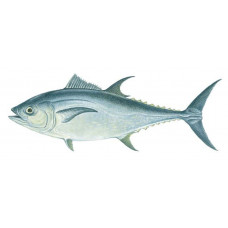Latin name
Thunnus thynnus
Other names
Atlantic bluefin tuna, northern bluefin tuna, tunny fish, horse-mackerel; Arabic: tunna; Chinese: cá chan, thu; French: thon rouge; Italian: tonno; Japanese: kuromaguro; Norwegian: sjorjf, thunfisk; Portuguese: atum, rabilha; Spanish: atún aleta azul, atun rojo; Turkish: orkinos.
Identification
Body shape typical of tuna. Bluefin tuna has a fusiform body, compressed and stocky in front. It can be distinguished from almost all other tuna by its rather short pectoral fins, which extend only as far as the eleventh or twelfth spike in the first dorsal fin. The first dorsal fin has 12–14 spines and the second has 13–15 rays. The anal fin has 11 to 15 rays. They have the largest number of gill wings of all Thunnus species - from 34 to 43 on the first arch. The ventral surface of the liver is striped, and the middle lobe is usually the largest. Dorsum and upper flanks dark blue to black, with gray or green tint. The lower flanks are silvery, with gray spots and stripes. Anal fin dusky and slightly yellow. The fins are yellow with black edging. The caudal keel is black in adults and translucent in translucent.
Distribution
Bluefin tuna are found in subtropical and temperate waters of the North Pacific and North Atlantic, as well as in the Mediterranean and Black Seas. They are widely distributed throughout the Atlantic. In the western Atlantic, they are common along Labrador and Newfoundland south to Tobago, Trinidad, Venezuela, and the Brazilian coast. They are particularly common to anglers off Nova Scotia and Prince Edward Island, Cape Cod, Montauk, New York, in canyons off New York and New Jersey, around North Carolina and the Bahamas. In the eastern Atlantic Ocean, it is common as far north as Norway and Iceland and as far south as northern West Africa. Atlantic bluefin tuna spawn in the Gulf of Mexico from April to June, and in the Mediterranean Sea in June and July.
Habitat
Bluefin tuna is a warm-water epipelagic and mesopelagic, gregarious fish.
Size
Bluefin tuna can reach more than 10 feet in length and are usually found between 16 and 79 inches long. Adults weigh between 300 and 1,500 pounds, although fish over 1,000 pounds are rare. The world record for all-tackle catches is held by a Nova Scotia fish that weighed 1,496 pounds when it was caught in 1979. Reportedly, this species can live for 40 years. It grows very quickly, at the end of the first year it is 51-69 cm long, the second year 54-92 cm, the third year 77-112 cm, the fourth year 100-128, the fifth year averages 128 cm and the sixth year 142 cm. Sexual maturity occurs at the age of three years.
Life history and Behavior
Bluefin tuna are warm-blooded and capable of maintaining their body temperature 18 °F above ambient water temperature, making them caiman is highly adapted to temperate and cold waters. They retain 98% muscle heat, have perhaps the highest metabolism of any known fish, and are among the fastest and broadest animals on Earth. They can go up to 35 miles per hour while hunting. Bluefin tuna are schooling fish and are collected by size, although the largest schools are formed by the smallest individuals and the smallest schools consist of the largest fish. They swim in a single formation, side by side (soldier formation) or in an arc (hunter formation). Extensive migrations are associated with water temperatures, spawning habits, and seasonal movements of foraging species. In the western Atlantic, they become sexually mature at about 8 years of age (curved fork length of 80 inches) and in the eastern Atlantic, at 5 years of age (60 inches).
Food and feeding habits
The diet of bluefin tuna consists of squid, eels, and crustaceans, as well as pelagic schooling fish such as mackerel, flying fish, herring, whiting, and mullet. It feeds mainly on sardines and anchovies in the Sea of Japan. Off the coast of California the main food item is anchovies, in the Gulf of Mexico - pelagic crustaceans. In the northern seas the food consists mainly of herring, mackerel, sardines, anchovy, garfish, and cephalopod mollusks.
Reproduction
Spawning in the Mediterranean Sea occurs in May-June; in the Sea of Japan, it begins in April and peaks in May-June. Off the coast of California, spawning lasts from December through May. Fecundity varies depending on the size of fish and reaches 10 million eggs in individuals weighing 270-300 kg. The eggs are spherical, 1.0-1.3 mm in diameter, and contain a fatty yellow drop. The development of the eggs takes about two days. The newly hatched larvae are 3 mm long.
| Classification | |
| Phylum | Chordata |
| Class | Actinopterygii |
| Squad | Scombriformes |
| Family | Scombridae |
| Genus | Thunnus |
| Species | T. thynnus |
| Features | |
| Conservation status | Least Concern |
| Habitat | Pelagic |
| Life span, years | 50 |
| Maximum body weight, kg | 680 |
| Maximum length, cm | 250 |
| Sailing speed, m/s | No information |
| Threat to people | Edible |
| Way of eating | Predator |




